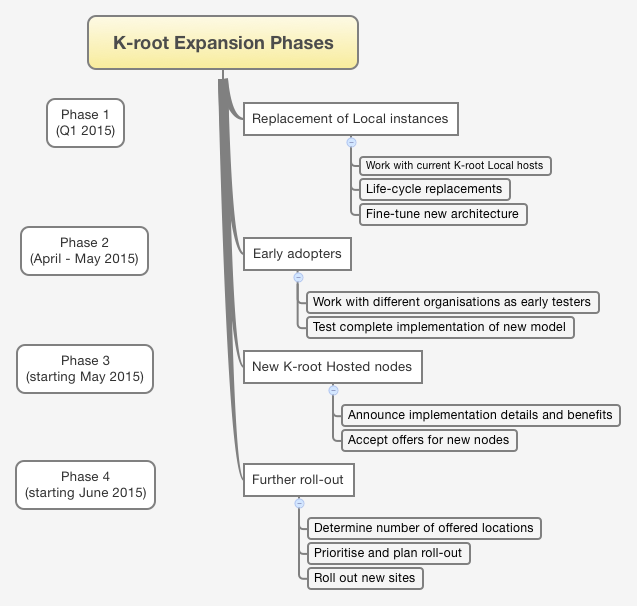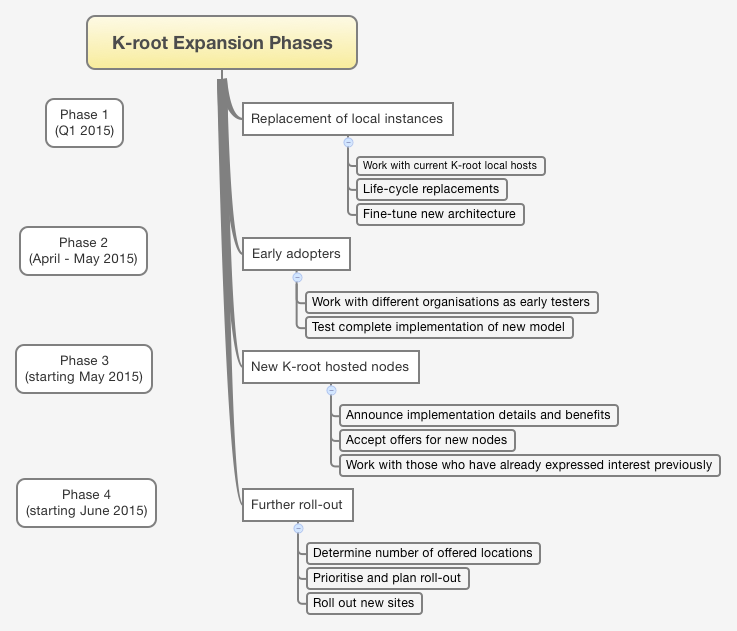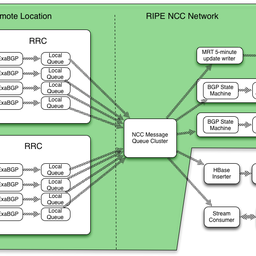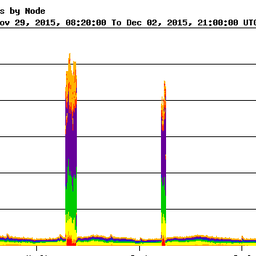We're getting ready to expand K-root coverage, and we'll soon be inviting interested members of the community to express their interest in hosting their own K-root node. Learn more about how we propose expanding the network, what the requirements are for hosting your own K-root node, and the projected timeline.
As previously announced , one of the things we're focusing on in 2015 is the expansion of the K-root network. Over the past several years, many of our members and those in the wider Internet community have expressed interest in hosting their own K-root node, and we believe that a more widely distributed K-root network could help improve access to K-root for Internet users within the RIPE NCC service region and around the globe.
The RIPE NCC will consider requests from any organisation interested in hosting a K-root node. We are particularly interested in those that can host nodes in currently under-represented regions within the K-root network in order to improve latencies within those regions, and will determine this based on our measurements . Depending on the number of requests we receive, we'll balance this by giving priority to potential hosts within the RIPE NCC service region . We'll also reach out to those organisations that have already expressed interest in hosting a K-root node, again prioritising those that will improve root server availability, both within the RIPE NCC service region and globally.
We are currently in the initial phase of the K-root expansion project, and expect to begin considering requests from interested potential hosts by mid-May. There will be a separate announcement when we start that phase. The diagram below illustrates the planned timeline for this project.
Added 21 May 2015: In the meantime these plans were discussed with the RIPE community at the RIPE 70 Meeting on 13 May 2015. You can find more information on our web site about hosting a K-root node .

Phase 1
New deployment model
We recently described the new architecture model for K-root hosted nodes (previously called local instances). This new model is much simpler and more cost effective for the hosts, and reduces the operational overhead on our side. This allows us to support more nodes without the need to increase the engineering staff at the RIPE NCC. It also means we don't need to increase K-root's operational budget in 2015. (Depending on the number of interested hosts, it's possible that the expansion could get large enough that we would need to increase the budget in order to support it at some future point in time; however, we will consult our membership and the community for guidance before that happens.)
During the past few months, we approached those hosts whose K-root local instances (the old model) were due for a life-cycle replacement and presented them with the new architecture model. Most of these hosts were enthusiastic to work with us to test the new setup as a replacement for the old K-root local instances. In this way, we have already rebuilt the nodes in India, Hungary, Poland, Switzerland and Australia, and we are in the process of doing the same with most of the remaining seven K-root instances. Working with these local K-root hosts has given us a chance to test the new configuration in an actual operational environment and confirm and fine-tune the model.
Phase 2
Early testers and Internet exchange points
As a next step, we have chosen three organisations from those that showed an interest in hosting a node in the past and asked them to become early testers of the new model. These organisations were not previously hosting one of the old local instances, but instead can help us test the entire new model from the first steps through complete deployment. We chose these three parties for several reasons: they had already expressed interest, we already had a relationship with them and knew they could satisfy the technical requirements of hosting a node, and they represent three different types of organisations that we believed would be a good test for the new model. These testers will also help us iron out any procedural wrinkles in their respective regions. The test hosts working with us in this early phase are: 1&1 Internet AG (AS8560), an Internet service provider; SwissIX (AS20612), an Internet exchange point; and ITC (AS12880), an aggregating country-level service provider.
At the same time, we are also working with other members of the community, such as Internet exchange points (IXPs), to help cover corner cases, such as specific IXP configurations.
Phase 3
Accepting new offers
We expect more requests from interested parties than we can immediately support, so we will need to pace the roll-out and prioritise those requests. We will consider each request and determine the priority of new locations taking the following aspects into account:
- The expected improvement of global K-root coverage and reachability, based on our measurements
- Location within/without the RIPE NCC service region
- Host's ability to satisfy technical requirements
In October 2014, we announced an experiment to improve the reachability of K-root. Using RIPE Atlas, we measured the latency and hop count to the K-root infrastructure in various regions. We will use the results of this experiment as input to select the best locations for new nodes. We will then also measure the impact of newly added nodes and publish the results here on RIPE Labs. Based on the results of these experiments, we may also approach potential hosts in parts of our service region, or beyond, where we see longer delays to reach other K-root nodes.
An outline of the implementation process can be found in the appendix . We will discuss the details of this process with the community at RIPE 70 in May. Meanwhile, we are open to feedback from the community at any stage.
Those who have already expressed interest
Over the last few years, we received many requests from organisations. At the same time, we will contact all those organisations that were interested in hosting a K-root node over the past few years so that we can confirm their continuing interest and their ability to satisfy the technical requirements, both in networking and local colocation facilities. We will evaluate all responses and discuss potential deployment dates for each of these hosts individually.
Understanding the benefits of hosting a K-root node
It is important for any potential hosts to be realistic about the possible benefits of hosting a K-root node before they request one. To help with this, we will publish a clear outline of what can - and can't - be expected in terms of latency, bandwidth use, traffic and other considerations. This outline will be available in May, when we will begin accepting requests from interested parties.
Monitoring and problem resolution
We constantly monitor the performance of all existing K-root nodes, and will continue to do so for all of the new ones. In case we see any negative impact on the service as a whole from a specific location, we stop advertising the K-root prefix at that location. Traffic is automatically rerouted to other nodes while we investigate and fix the issue at hand. In case the cause of the problem is in the upstream network, we will ask the local host to investigate and remedy the situation. When the problem has been solved, as verified by our tests, the prefix advertisement will be re-enabled.
Involving the community
We want to stress that these are our initial plans for expanding the K-root network, but we will be looking to the community for feedback, both now and when we announce more details about its implementation in May, and will continue to seek guidance about how to proceed in the future as the expansion project evolves.
Appendix: Proposed hosted K-root node implementation process
In May w
e will be
ready to consider requests for new K-root hosted nodes. This is the general outline of the implementation process we will go through with each potential host.
-
The host provides the required information
(details about how to provide this information will be announced in May).
- The RIPE NCC verifies the technical and non-technical requirements.
- The RIPE NCC considers the offer and informs the host of the expected implementation period. We will consider the expected improvement to K-root coverage as well as whether the host is located within the RIPE NCC service region.
- The host and the RIPE NCC enter a memorandum of understanding (details will be available in May).
- The host orders the necessary equipment according to the given specifications.
- The host prepares the equipment and network set-up.
- The RIPE NCC configures the K-root server, including BGP peering with local host to announce the K-root prefix from AS25152.
- The host configures BGP peering and propagates the K-root prefix upstream.
- The RIPE NCC monitors the impact of the new routing arrangements.
- If needed, the RIPE NCC and the host work jointly to fine-tune the prefix advertisements.
At the end of this process, the new K-root hosted node will be part of the K-root service infrastructure.





Comments 0
The comments section is closed for articles published more than a year ago. If you'd like to inform us of any issues, please contact us.